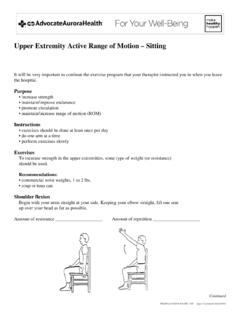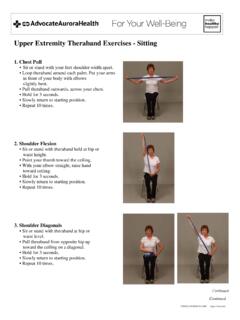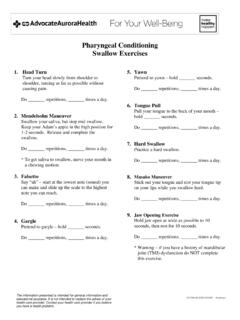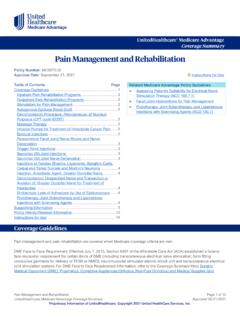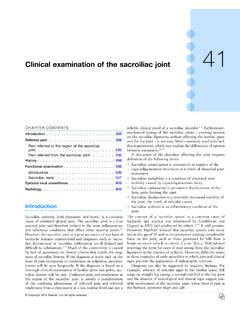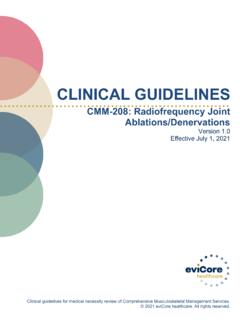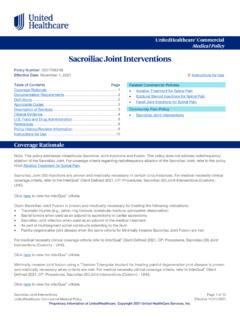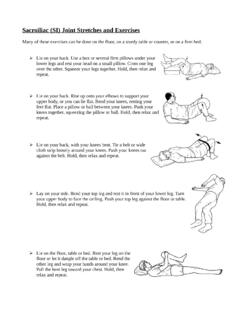Transcription of Sacroiliac Joint Information and Home Exercise Program
1 Sacroiliac Joint Information and Home Exercise Program The Sacroiliac Joint or SI Joint is an irregularly shaped Joint which joins the base of the spine (sacrum) with the pelvic bone (ilium). The pubic bone, which is part of the pelvis, is also a Joint which moves in synchrony with the SI Joint . These joints all move slightly during bending, walking, etc. If trauma or repetitive overuse occurs, the motion in these joints may increase and become hypermobile (looser than normal), causing excessive wear and tear and pain. To prevent irritation of a SI Joint problem follow these recommendations: Don't skip steps up or downstairs.
2 Don't jump on one leg. Don't take long steps. Don't cross your legs. Do sit with your legs wide. Maintain erect posture. Don't stand with weight on one side. Don't carry heavy objects (groceries, baby) on one side (hip or shoulder). Use caution during sexual activity. (If you have questions, consult your therapist). Avoid having partner bear weight on you. Be in a non-weight bearing position. Avoid positions which causes asymmetry (increased weight bearing on one side more than the other). Quadratus Lumborum 1. Lie on your uninvolved side with a towel roll under your side (between your ribs and pelvis).
3 Move your pelvis gently up toward your shoulder and down toward your heel in a rocking motion. Perform repetitions, sets. 2. Sit with the involved side buttock off the edge of a chair. Gently drop the involved hip off the chair in a pain-free range and then raise the hip and pelvis hiking them up and away from the floor. Perform repetitions, sets. Repeat above sequence on right. X08387 (12/2019) AHC. Continued X11635 (Rev. 09/11) AAHC Lumbar/Pelvic X08387 (12/2019) AHC. Continued X11635 (Rev. 09/11) AAHC Lumbar/Pelvic Sacroiliac Joint Information and Home Exercise Program , Page 2.
4 Quadratus Lumborum/Gluteus Medius Exercise 3. Pelvic Rising and Lowering Stand on a step with your foot on the step. Hold railing for support. Slowly elevate and lower your hip. Perform repetitions, sets. 4. Standing Stabilization Stand with your side to the wall. Raise your leg with knee bent as in the picture. Keeping your hips level, press your foot and knee into the wall as if trying to rotate your leg into the wall. Hold seconds, perform repetitions, sets. 5. Mule Kick Leaning forward with your back supported on a table begin with knee bent as pictured.
5 Straighten your knee and turn your foot out as you slowly extend your leg behind you. Perform repetitions, sets. 6. Step Up Starting position as in Figure A . Place your left foot on a step facing forward. Step up on your left foot as you rotate your trunk and right leg to the right, with the right leg extended behind you. (Keep your trunk erect). Perform repetitions, sets. Repeat above sequence on right foot. Figure A Figure B. Starting position for Hip and knee step-up Exercise . extension rotation at end range. The Information presented is intended for general Information and X08387 (12/2019) AHC.
6 Educational purposes. It is not intended to replace the advice of your Continued health X11635 care provider. (Rev. 09/11) Contact AAHC your health care provider if you believe Lumbar/Pelvic you have a health problem. Sacroiliac Joint Information and Home Exercise Program , Page 3. 7. Squat Stand with your legs shoulder width apart. Keeping your spine in its neutral position, and buttocks tight, sit back as if sitting into chair. Allow your trunk to lean forward by bending at your hips. Do not let your knees pass your feet.
7 Perform repetitions, sets. Option: Squeeze towel roll between thighs as in Figure B. as you perform the squat. Figure A Figure B. 8. Iliotibial Band Self Stretch Lie on your involved side supporting your body weight on your elbow and top leg (see diagram). With the 2 foam roll under your involved thigh, slowly glide your outer thigh (iliotibial band) on the roll from your knee to your hip. Perform times, times/day. 9. Bridge With Adduction Lie on your back with your knees bent and slightly apart, feet flat on the floor. Squeeze a rolled towel between your knees as you raise your buttock off the floor.
8 Hold seconds, perform repetitions, sets. 10. Hip Clam . Lie on your side with your knees bent and hips stacked one over the other. Keeping your feet together slowly raise your top knee toward the ceiling. Do not roll back. Hold seconds. Perform repetitions, sets, times/day. 11. Forward Lunge Step forward with your front foot pointing straight ahead and your knee just over your foot. As you lower into a lunge position your back knee drops and your trunk leans forward at the hip. Keep the buttock tight as you stand up and regain upright position.
9 Perform repetitions, sets. The Information presented is intended for general Information and educational purposes. It is not intended to replace the advice of your health care provider. Contact your health care provider if you believe you have a health problem.







